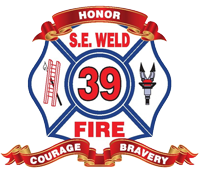Southeast Weld Fire Protection District would like to take the time to remind homeowners/businesses to take steps to help prevent potentially fatal carbon monoxide poisoning.
Carbon monoxide is a colorless, odorless gas that is produced by incomplete combustion in home heating systems, gas ovens, dryers, fireplaces and automobile engines. Prolonged exposure to carbon monoxide can be fatal.
The symptoms of carbon monoxide poisoning are flu-like and often include headache, sleepiness, weakness, vomiting, dizziness and tightness in the chest. If you or your family experiences these symptoms: Call 911 or seek emergency medical attention. Stop using the suspected gas appliance immediately and call Atmos Energy’s Emergency hotline at 1.866.322.8667. Do not use the appliance until it has been inspected, serviced and determined to be safe by a qualified plumber or a heating contractor.
Help prevent carbon monoxide poisoning:
- Hire a qualified heating system professional each year to inspect all natural gas appliances and venting systems in your home to ensure that they are working properly. Atmos Energy customers can find qualified plumbers and contractors by visiting www.atmosenergy.com
- Install carbon monoxide detectors in the home on all floors where bedrooms are located. Detectors identify traces of carbon monoxide in the home and sound an alarm when carbon monoxide is detected.
- Do not idle a car in an attached garage. Doing so allows a large amount of carbon monoxide to enter the home. Instead, back the car completely out of the garage and close the garage door while the vehicle warms up.
- Make sure that your chimneys and flues are clean and unobstructed and that appliances have proper ventilation systems.
- Remove clutter from around gas furnaces and water heaters to ensure an adequate supply of fresh air. Change furnace filters regularly.
- Do not use natural gas ovens as a heating source. The burning of natural gas produces carbon monoxide that is safely ventilated when the oven door is closed, but is released into the kitchen when the door is open.
- Do not use charcoal indoors for either cooking or heating. Burning charcoal releases carbon monoxide.
- Make sure kerosene and other portable heaters are vented to the outside.


